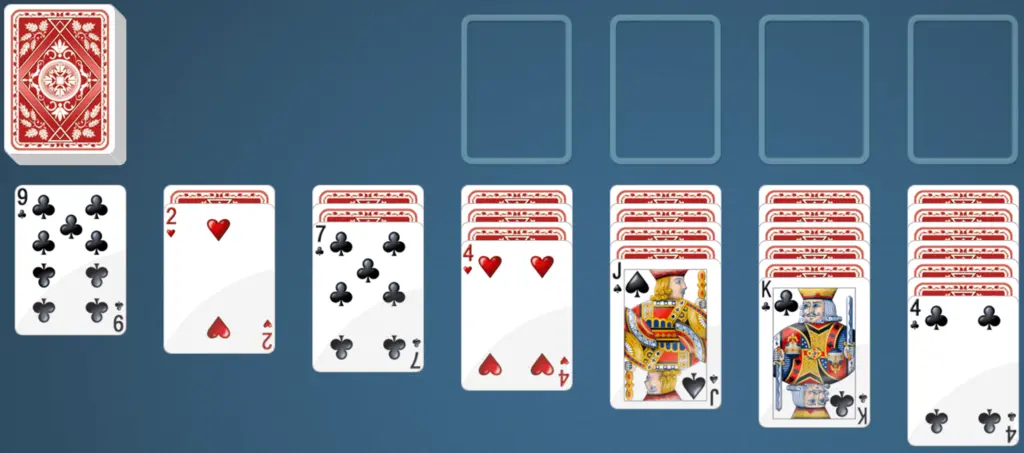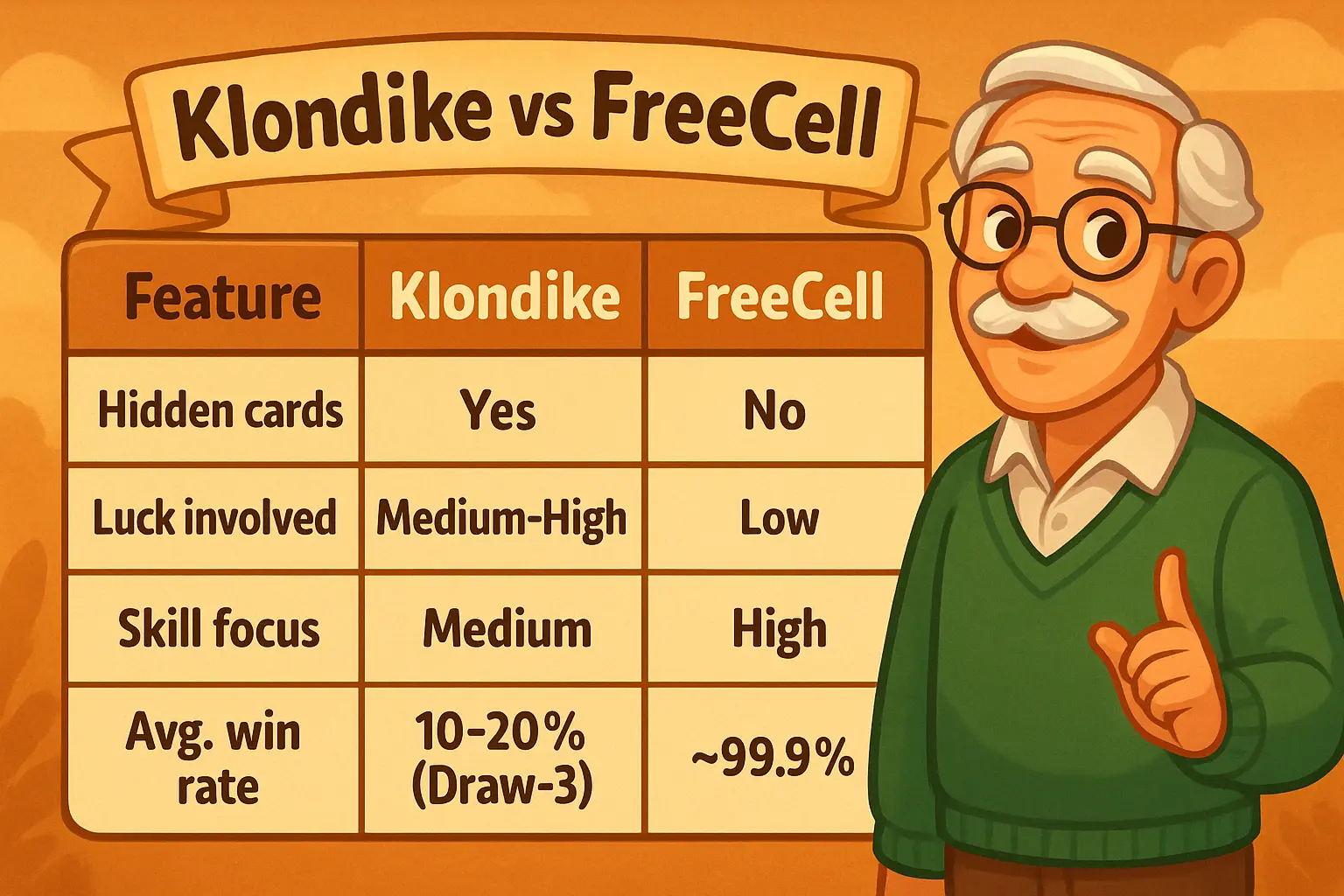How to Play Klondike Solitaire: Your Zero‑to‑Hero Crash Course

You’ve opened the game, seen seven messy piles of cards, and thought, “Cool… now what?” Grab a cup of coffee—I’ll teach you Klondike (the classic Windows Solitaire) in five friendly steps. By the end, you’ll know exactly what to do, why to do it, and how to spot those sneaky winning moves.
What Is Klondike Solitaire?
Klondike Solitaire is the classic card game that most people recognize as “Solitaire”—especially if you grew up playing it on an old Windows computer. It's been the go-to digital time-killer for decades, and for good reason.
What makes Klondike so popular? It hits the perfect balance between luck and logic. Unlike some solitaire variants where every game is winnable (like FreeCell), Klondike introduces mystery and suspense with hidden cards. You don’t know what’s buried until you play smartly and reveal them.
Every game feels like a mini puzzle—sometimes it’s a breeze, other times it’s a brain-bending challenge. You win by stacking all 52 cards into four suit piles in perfect Ace-to-King order. But to get there, you’ll need to carefully maneuver your way through limited moves, blocked cards, and the occasional heartbreak of a no-win deal.
In short:
It’s simple to learn, tough to master
There’s always a new challenge
It rewards planning, but luck plays a hand too
That's the magic of Klondike.
Klondike Solitaire Card Game Setup (Decode the Card Chaos)
When you first open a game of Klondike Solitaire, it might look like someone dropped a deck of cards on the table. But there’s a method to the mess. Here’s how everything is laid out:
1.The Tableau
This is your main playing area—seven columns of cards, each stacked with a specific number of cards:
Column 1: 1 face-up card
Column 2: 1 face-down + 1 face-up
Column 3: 2 face-down + 1 face-up
…
Column 7: 6 face-down + 1 face-up
Only the top card in each column is face-up at the start. Your goal is to uncover the hidden cards by moving the top ones around.
2. The Stock & Waste Pile
The stock is the leftover pile of face-down cards that didn’t go into the tableau. You’ll draw from this pile when no more moves are available on the board.
Stock pile: Draw cards one by one (or three at a time, depending on the mode).
Waste pile: If a drawn card can’t be played, it goes here—cycling back through later.
Think of this as your backup plan—but with limited access depending on the rules.
3. The Foundations
At the top of the board are four empty foundation piles, one for each suit: ♥ ♠ ♦ ♣.
This is where you ultimately want every card to end up, starting with the Ace and building up in perfect order:
Ace → 2 → 3 → … → King

Game Objective
Your mission in Klondike Solitaire is simple in theory but tricky in practice: move all 52 cards into the four foundation piles, one for each suit—♥, ♠, ♦, and ♣.
To build each foundation:
You must start with an Ace
Then stack cards in ascending order by suit:
Ace → 2 → 3 → … → Jack → Queen → King
No mixing suits, no skipping ranks. Each pile must be perfectly ordered from the ground up.
You’ll do this by moving cards around the tableau, uncovering hidden cards, and playing from the stock pile—all while following the golden rules of alternating colors and descending ranks.
Complete all four foundations, and you win the game. Easy to say—hard to master!
Klondike Solitaire Rules (Tattoo These on Your Brain)
To win at Klondike, you don’t need to memorize dozens of rules—just master these two golden ones. Everything else is just clever shuffling around them.
Building in the Tableau
This is where most of your gameplay happens. In the tableau (the seven columns), you can move cards down in rank and they must alternate colors.
Example:
✅ A red 7♥ can be placed on a black 8♣
❌ But a red 7♦ cannot be placed on a red 8♥
You can also move stacks of correctly ordered cards, not just single ones—as long as the move follows the same descending + alternating color rule.
Building the Foundations
Foundations are where you send cards home. You build them upward and by suit only, starting with the Ace of each suit.
Example:
A♥ → 2♥ → 3♥ → 4♥ … all the way to K♥
No color-switching or rank-jumping allowed. Once a card goes to a foundation, it’s there for good—so make sure you’re not locking yourself out of moves too early!
How to Play Klondike (Move-by-Move Tutorial)
Now that you know the setup and the rules, let’s walk through exactly how a game of Klondike plays out—step by step.
Step 1: Scan the Tableau for Legal Moves
Start by looking for cards you can move between columns.
Remember: moves must go down in rank and alternate colors.
Step 2: Move Aces to the Foundations ASAP
Whenever you spot an Ace, send it to the foundation right away.
That opens the door to start building that suit’s stack upward.
Step 3: Draw from the Stock if You’re Stuck
No more moves on the board? Flip cards from the stockpile.
Play any card that fits into the tableau or onto the foundations.
Unplayable cards go into the waste pile—don’t worry, you’ll cycle back to them.
Step 4: Flip Face-Down Cards When You Uncover Them
As soon as you move a face-up card from a column, flip the hidden card underneath.
This expands your playable options and brings you closer to victory.
Step 5: Use Empty Columns Wisely (Kings Only!)
Only a King—alone or leading a proper descending stack—can move into an empty tableau column.
So don’t clear a pile unless you’ve got a King ready to slide in.
🧠 Pro Tip: Only Kings or King-led stacks can occupy empty columns. If you empty a column without a plan, you might stall the whole game.
Step 6: Repeat Until You Win (or Run Out of Moves)
Keep cycling through those steps: build in the tableau, uncover cards, shift Aces to the foundations, and draw from the stock.
You win when all 52 cards are safely stacked in their foundation piles.
Or you run out of moves and hit restart. (We’ve all been there.)
Top 5 Klondike Tips to Win More
Want to go from casual shuffler to confident card-slinger? These five tips will boost your win rate and help you outsmart even the trickiest deals:
1. Flip Hidden Cards Early
The more face-up cards you have, the more options you unlock.
Prioritize moves that reveal hidden cards—even if they don’t look flashy at first.
2. Hold Off on Low Cards if They Block Options
Sure, sending that 2♥ to the foundation feels productive…
But it might block you from stacking a black 3♣ later.
Be patient with low cards if they’re still useful in the tableau.
3. Use Empty Columns to Reposition Stacks
Empty tableau columns are powerful tools.
They give you space to move long card sequences and reset awkward layouts.
Always try to keep one free—if you have a King to fill it.
4. Plan Multiple Moves Ahead
Don’t just grab the first legal move.
Pause and ask: What will this uncover? Will it help me long-term?
Smart planning wins more games than lucky draws.
5. Undo Is Your Friend (Especially in Apps)
“Undo” isn’t cheating—it’s studying.
Try a move, rewind, and explore another option.
The more you experiment, the more patterns you’ll start to recognize over time.
Klondike Game Modes (Dial Up or Down the Challenge)
Klondike isn’t one-size-fits-all—you can tweak the rules to match your skill level or mood. Here are the most common variations:
Draw-1
Flip one card at a time from the stock pile.
This version gives you more control, better visibility, and a higher win rate—perfect for beginners or anyone wanting a more relaxed experience.
Draw-3
Flip three cards at a time, but you can only play the top card of the three.
It’s the traditional challenge mode from old-school desktop Solitaire.
Winning requires careful planning, deeper strategy, and a little more patience.
Vegas Mode
Feeling bold? Try Vegas Mode, where each draw “costs” you pretend money, and each card added to the foundation earns it back.
Can you finish in the black?
This adds a layer of strategy and pressure—and turns Solitaire into a score-chasing game.
No matter the mode, Klondike always rewards practice and smart thinking. Choose your challenge and see how far you can go!
Klondike vs FeeCell

Final Tips From the Pros
Ready to level up your game? Here are a few last nuggets of wisdom that experienced Klondike players live by:
Always Think in Sequences, Not Just Individual Moves
Don’t get tunnel vision. Instead of focusing on one card, ask yourself:
What stack does this move unlock? What chain reaction can I trigger?
Great Klondike play is about seeing the bigger picture.
When Stuck, Revisit the Waste Pile Cycle Timing
In Draw-3 mode especially, timing is everything.
If a needed card is buried in the waste pile, you might need to skip a move or delay a play to realign the cycle.
Small choices can bring buried cards back into reach.
Don’t Auto-Complete Too Soon
We get it—it’s satisfying to see the cards fly into place.
But hitting “auto-complete” too early can rob you of opportunities to rearrange the tableau or unlock a better foundation path.
Finish strong by playing it smart, not just fast.
Patience, planning, and a bit of card-savvy go a long way. Stick with it, and you’ll be winning more often than not.
Ready to Play Klondike Solitaire?
Whether you're chasing a win streak, trying to beat your personal best in Vegas mode, or just relaxing between tasks, Klondike Solitaire is the perfect blend of strategy, luck, and timeless fun. And if you’re craving even more excitement, games like Solitaire Home Story take the classic format and add a cozy twist—combining puzzles with home renovation adventures. No matter how you play, one thing’s for sure: every great solitaire story starts with a single move. So shuffle up, dive in, and make it count.
Related Articles:
How to Play Scorpion Solitaire: The Messy Rescue Mission
Types of Solitaire Card Games: A Complete Guide to Classics, Variations, and Modern Twists
How to Play Golf Solitaire: Quick Swings, Brutal Bogeys
